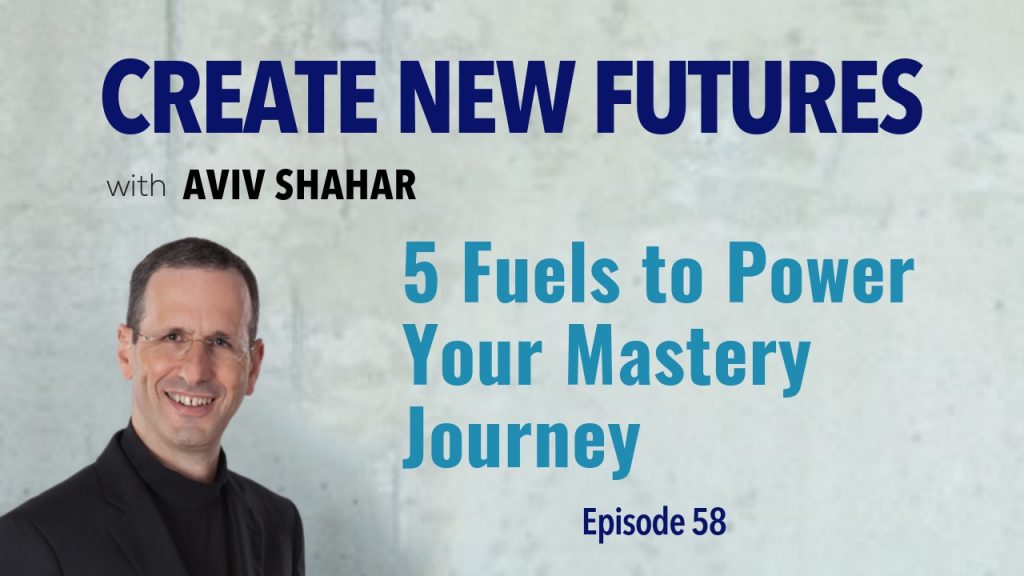Hi Leader,
In my recent article How to Reach Mastery, I discussed what the best CEOs do to lead their teams along the three-legged journey to realize mastery. I reflected on the Biblical wandering in the desert as a necessary development crucible of resistance and relayed a Shakespearean insight from Al Pacino to describe how a critical readiness enables the performance elevation that occurs with the attainment of mastery. In this article's further reflection on the journey to mastery, you will find answers to a crucial question: What propulsions can power the journey in the development desert?
5 Fuels to Power Your Mastery Journey
"Audaciously utopian visions often get actualized a century later."

Listen here: Episode 58: 5 Fuels to Power Your Mastery Journey
First, let's review briefly the three-legged journey to achieving mastery that reflects and addresses the Einstein puzzle. Einstein's maxim was: "We cannot solve our problems with the same thinking we used when we created them." His observation was that the answer cannot be found where the question arises. Instead, resolving the problem requires you to find an elevated vantage point where the answer naturally appears.

The first leg of the journey, represented by the vertical ascending arrow on the left, signifies the emergent awareness of a need. For individuals, the awareness that triggers a need for a development change can be initiated situationally from their professional and personal environments and from their interior mindful reflection.
Similarly, an awareness that an organizational change is necessary can be activated by internal systems and/or, as is often the case, by the changes and developments that occur in the broader ecosystem.
Often the awareness is triggered by a deficiency and the experience of shortfall. Conversely, the awareness can be awakened by an aspirational impulse. In life and at work, the deficiency and the aspiration can appear next to one another. Here are a few examples:
The individual shortfall trigger can be:
- Feeling overwhelmed by circumstances (I need to grow my capacity to handle complexity.)
- Failing to meet a requirement (I need to build discipline.)
- Experiencing health issues (I must make a life style change.)
- Feeling out of one's depth (I must develop the necessary acumen, so I can contribute to the conversation.)
The aspirational impulse may be a(n):
- Visionary idea (I bring an innovative solution to this situation.)
- Development urge (Let me develop my potential to be the most versatile I can be.)
- Ambition (I want to become the CEO.)
- Passion (I am excited to overcome perceived limitations by building greater stamina.)
Organizational shortfall triggers can be:
- We missed our numbers.
- Our market share declined when competitors entered our markets.
- We are failing to meet our customer satisfaction standards.
- Our communications have broken down and our decision-making is dysfunctional.
The organizational aspirational impulse may be:
- We have an opportunity to transform the lives of our customers and lead the sector.
- Our purpose is to promote happiness and wellness.
- We are inspired to create the best work environment.
- We have an opportunity to innovate and grow.
In the graphic, the apex of the left ascending arrow represents a point of critical recognition, where a change is catalyzed, and a new action is taken. This is the beginning of the horizontal leg of the journey, signifying the path of development (practice). The development leg of the journey is where you pay your dues, overcome challenges and resistance, and are molded by the crucible of resistance to fashion critical readiness.
A twofold realization occurs on the development (practice) path. First, the propelling energy and intensity that carries you forward is the reason why you are pursuing the specific development. Second, the initial reason for the journey often is insufficient to carry you through and overcome the obstacles and resistance you will encounter. Thus, you must rededicate yourself and discover new and deeper reasons that provide the enduring drive and persistence power needed to cross the development desert.
For example, the initial triggers of lack of confidence and low self-esteem may lead to an awareness that I need to build my communication and presentation skills to help me boost my confidence and self-worth. Then, as you embark on building these skills and discover new interests and passions, you may choose to update your inner narrative to access the enduring power of I am building my confidence and communication skills to enable me to be an effective contributor, teacher and coach.
The first propulsion is the desire to escape the impediment you found in point A in the drawing below. The second propulsion is what compels you to drive to point B

Reaching the critical readiness found at point B requires a combination of internal and external timing. It is here that the vertical ascent of elevation (mastery) occurs. Before the Beatles became the Beatles phenomenon, they played long nights in a Hamburg club. Google was not the first search engine, Facebook was not the first social network and the iPhone was not the first smart phone. The convergence of superior design prowess with technological and market maturation and ecosystem readiness enabled these phenomenal growth trajectories.
If you trace story after story of individual "overnight success," you will find that they all were preceded by a development (practice) journey before the elevation of mastery occurred.
What propulsions can power the development journey?
Your development (practice) always faces resistance. This fact represents basic Newtonian physics. In whatever arena you focus on developing mastery - a technical field, business, entrepreneurship, leadership, the arts, sports, communication, caring, love, patience, courage or humor - you will face resistance. Resistance is purposeful. It forces you to steel your determination and find new sources of power and fortitude to cross the development desert.
Sure, natural talent makes an enormous difference. For example, even if I practiced a million years, I could not be the next Lang Lang at the piano or Meryl Streep on the screen, any more than I could be LeBron James on the basketball court, Katie Ledecky in the swimming pool or Lionel Messi on the soccer field. They all are uniquely gifted performers.
Why do I reflect on these names and other super masters of their fields? First, we love these superstars because they thrill us. Then I am aware that people often use superstars as an alibi for what they tell themselves they cannot become. That's a mistake. Rather than use superstars as an excuse to disempower yourself and prove that you can never do and become someone who achieves at that level, reflect on these individuals to make the point of mastery, and to encourage your inner Messi, your inner Streep, or whatever is your dedicated genius may be.
My point is that there are a million ways to find and reach the elevation of mastery. The rare few involve fame and celebrity power. They too paid their dues, worked to refine their crafts and needed to find the fuel to overcome resistance on the path to mastery.
Here are the questions for you to ponder: what mastery are you working to develop? What resistance(s) are you encountering? What is the fuel that powers you through?
There are five propelling fuels I have observed people use to help them cross the development desert and overcome the difficulties of what at times can be experienced as the lonely struggle of resistance.
- Pain/Fear: I don't know if I'll be able to go on, if I don't make this change. My life depends on this development. Pain and fear (including fear of pain) can be the most powerful catalysts for movement. At the same time, fear brings dual problems. First, when the pain and/or fear subsides, the propelling force dissipates. Second, fear is a cortisol-driven behavior. A neurobehavioral system working over a prolonged period on cortisol tends to become dependent on the cortisol pathways and thus creates extremely unhealthy side effects. Still, fear works to drive results. The ethos of fear as a driver was captured in Andy Grove's idea that "only the paranoid survives."
- Passion/Reward: I am excited by this challenge and the results I'll be able to create. Passion and reward involve dopamine, which is present when you experience yourself in a state of flow. Reward and passion can be catalyzed by internal and external stimuli. An example of the latter is when you love to make people laugh, you follow your joy and pleasure to become a standup comedian. An internal stimulus example is when you discover that you love the creative process of ideating and generating jokes, and you follow that passion by writing the jokes for comedians.
If you are passionate about cooking, you may be propelled by a vision of being the chef in your own restaurant. Although one driver may be the desire to be rich and famous, in most situations it is insufficient to create sustained success. However, if your reward is pleasing your patrons with great and beautiful experiences of the meals you prepare, this energy will drive you to overcome the many obstacles to thriving in the difficult and competitive restaurant business. - Serving a cause: This cause/belief/endeavor inspires me to be the best I can be and to overcome any obstacles. The sense of purpose found in serving a cause that you see and believe to be bigger and lasting even beyond you is a powerful driver. Whether it is helping others in need, protecting what is dear to you and or working to change a policy, the vision of how you impact an outcome you strongly believe in provides tremendous power, resilience and enduring resourcefulness in overcoming resistance.
- Team spirit: I am driven by my team members and the future we are creating together. Whether in the context of sports, professions, or danger and war, the energy that derives from the mutuality and loyalty of working together as a team to overcome challenges can be more powerful than anything else. I am writing this article during the World Cup games. It is obvious that the enthusiasm and spirit of a team effort ultimately wins, even when the other side has the best soccer player in the world.
- Structure of support: My environment offers supporting tools and creates accountability that reinforce our goals and objectives. In the business context, this driver is a critical element. Since corporate leaders and teams forever grapple with competing priorities and the tyrannical pressures of what often are totally unimportant matters masquerading as highly urgent, the environment, the management cadence, tools and processes all must be designed to reinforce what truly matters and to support and enable the core mission. In the corporate settings, drivers #4 and #5 very much need each other.
As you reflect on these five fuels, consider that you can be driven by the urgency of escaping point A because of pain and fear, and you can be driven by the compelling pull of point B when it is framed as a vision, a dream and the mastery you imagine. Ideally you renew and update what fuels your effort so that you can overcome resistance. Finally, in most situations you must combine multiple drivers, even all five of them, to realize your vision and reach mastery.
Now it's your turn. Turn the key. Discover what mastery are you building and what drives your success in overcoming resistance. Working to build critical readiness for mastery is a fantastically rewarding and meaningful journey. Then, when mastery dramatically elevates what you do in one of the special miracles of living, you will rejoice in the exalted dance of attainment as the domain you were seeking express itself through you.

